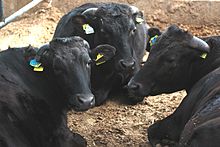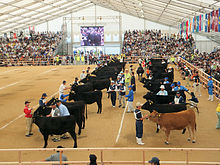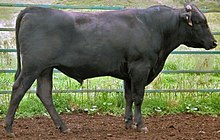Wagyu: Difference between revisions
m Fix link title and date Tag: Reverted |
m Fix link date Tag: Reverted |
||
| Line 30: | Line 30: | ||
In the United States, some Japanese Wagyu cattle are cross-bred with [[American Angus]] stock. Meat from this cross-breed is marketed as "American-Style Kobe Beef",<ref>{{cite news| url= http://search.japantimes.co.jp/cgi-bin/nn20110812f1.html |title= U.S. ranches breed famous Kobe-style beef| archive-url= https://web.archive.org/web/20110828063006/http://search.japantimes.co.jp/cgi-bin/nn20110812f1.html |archive-date=28 August 2011 |date= 12 August 2011 |work= [[The Japan Times]]| agency= [[Associated Press]]| page= 3| access-date= 19 November 2021}}</ref> or "Wangus",<ref>{{cite web | website=Business Insider | date=August 2, 2019 | last=Houston | first=Jack | title=The rarest steak in the world can cost over $300 | quote=Several US restaurants are serving hybrid "wangus" beef from domestically raised wagyu and Angus cows. | url=https://www.businessinsider.com.au/wagyu-beef-steak-cows-from-japan-so-expensive-2019-8}}</ref> although many American retailers simply (inaccurately) refer to it as Wagyu. Wagyu were first competitively exhibited at the [[National Western Stock Show]] in 2012.<ref name=NWSS>{{cite news|title=Tender Wagyu muscles onto meat scene, makes stock-show exhibition debut|url=http://www.denverpost.com/business/ci_19716708|newspaper=The Denver Post|date=11 January 2012|first=Steve|last=Raabe|url-status=live|archive-url=https://web.archive.org/web/20120113065658/http://www.denverpost.com/business/ci_19716708|archive-date=13 January 2012}}</ref> Other U.S. Wagyu breeders have full-blooded animals directly descended from original Japanese bloodlines, that are registered through the American Wagyu Association.<ref>{{cite web|url=http://wagyu.org/members/cattle-registration|title=Registration – DNA Tests – American Wagyu Association|website=wagyu.org|access-date=6 May 2018|url-status=live|archive-url=https://web.archive.org/web/20171001172708/http://wagyu.org/members/cattle-registration/|archive-date=1 October 2017}}</ref> |
In the United States, some Japanese Wagyu cattle are cross-bred with [[American Angus]] stock. Meat from this cross-breed is marketed as "American-Style Kobe Beef",<ref>{{cite news| url= http://search.japantimes.co.jp/cgi-bin/nn20110812f1.html |title= U.S. ranches breed famous Kobe-style beef| archive-url= https://web.archive.org/web/20110828063006/http://search.japantimes.co.jp/cgi-bin/nn20110812f1.html |archive-date=28 August 2011 |date= 12 August 2011 |work= [[The Japan Times]]| agency= [[Associated Press]]| page= 3| access-date= 19 November 2021}}</ref> or "Wangus",<ref>{{cite web | website=Business Insider | date=August 2, 2019 | last=Houston | first=Jack | title=The rarest steak in the world can cost over $300 | quote=Several US restaurants are serving hybrid "wangus" beef from domestically raised wagyu and Angus cows. | url=https://www.businessinsider.com.au/wagyu-beef-steak-cows-from-japan-so-expensive-2019-8}}</ref> although many American retailers simply (inaccurately) refer to it as Wagyu. Wagyu were first competitively exhibited at the [[National Western Stock Show]] in 2012.<ref name=NWSS>{{cite news|title=Tender Wagyu muscles onto meat scene, makes stock-show exhibition debut|url=http://www.denverpost.com/business/ci_19716708|newspaper=The Denver Post|date=11 January 2012|first=Steve|last=Raabe|url-status=live|archive-url=https://web.archive.org/web/20120113065658/http://www.denverpost.com/business/ci_19716708|archive-date=13 January 2012}}</ref> Other U.S. Wagyu breeders have full-blooded animals directly descended from original Japanese bloodlines, that are registered through the American Wagyu Association.<ref>{{cite web|url=http://wagyu.org/members/cattle-registration|title=Registration – DNA Tests – American Wagyu Association|website=wagyu.org|access-date=6 May 2018|url-status=live|archive-url=https://web.archive.org/web/20171001172708/http://wagyu.org/members/cattle-registration/|archive-date=1 October 2017}}</ref> |
||
| ⚫ | |||
| ⚫ | |||
=== Canada === |
=== Canada === |
||
Revision as of 20:22, 27 July 2023
You can help expand this article with text translated from the corresponding article in Japanese. (February 2022) Click [show] for important translation instructions.
|


Wagyu (Japanese: 和牛, Hepburn: wagyū, lit. 'Japanese cattle') is the collective name for the four principal Japanese breeds of beef cattle. All wagyū cattle derive from cross-breeding in the early twentieth century of native Japanese cattle with imported stock, mostly from Europe.[1]: 5
In several areas of Japan, Wagyu beef is shipped carrying area names. Some examples are Matsusaka beef, Kobe beef, Yonezawa beef, Ōmi beef, and Sanda beef. In recent years, Wagyu beef has increased in fat percentage due to a decrease in grazing and an increase in using feed, resulting in larger, fattier cattle.[2][3][4]
History

Cattle were brought to Japan from China at the same time as the cultivation of rice, in about the second century AD, in the Yayoi period.[5]: 209 Until about the time of the Meiji Restoration in 1868, they were used only as draught animals, in agriculture, forestry, mining and for transport, and as a source of fertilizer. Milk consumption was unknown, and – for cultural and religious reasons – meat was not eaten. Cattle were highly prized and valuable, too expensive for a poor farmer to buy.[1]: 2
Japan was effectively isolated from the rest of the world from 1635 until 1854; there was no possibility of the intromission of foreign genes to the cattle population during this time. Between 1868, the year of the Meiji Restoration, and 1887, some 2600 foreign cattle were imported.[1]: 7 At first, there was little interest in cross-breeding these with the native stock, but from about 1900, it became widespread. It ceased abruptly in 1910 when it was realised that, while the cross-breeds might be larger and have better dairy qualities, their working capacity and meat quality was lower.[1]: 7 From 1919, the various heterogeneous regional populations that resulted from this brief period of cross-breeding were registered and selected as "Improved Japanese Cattle". Four separate strains were characterised, based mainly on which type of foreign cattle had most influenced the hybrids, and were recognised as individual breeds in 1944.[1]: 8 They are collectively known as wagyū, and are:[5]: 66 [6]: 420 [7]
- The Japanese Black (黒毛和種, kuroge washu), which constitutes over 90% of beef cattle in Japan;[8] regional strains within the breed include the Tottori, Tajima, Shimane and Okayama.[9]
- The Japanese Brown or Japanese Red (褐毛和種, akage washu or akaushi), the other main breed, representing about 5% of all beef cattle;[10]: 17 reared in southern Japan, in Kōchi Prefecture on Shikoku island, and in Kumamoto Prefecture on Kyushu island.[1]: 8 [9]
- The Japanese Polled (無角和種, mukaku washu), found principally in Yamaguchi Prefecture[1]: 8
- The Japanese Shorthorn (日本短角和種, nihon tankaku washu), reared in northern Japan, mainly in Iwate Prefecture; it constitutes less than one percent of all wagyu cattle.[11]
Australia

The Australian Wagyu Association is the largest breed association outside Japan.[12] Both fullblood and Wagyu-cross cattle are farmed in Australia for domestic and overseas markets, including Taiwan, China, Canada, Hong Kong, Singapore, Malaysia, Indonesia, the U.K., France, Germany, Denmark and the U.S.[13] Australian Wagyu cattle are grain fed for the last 300–500 days of production.[citation needed] Wagyu bred in Western Australia's Margaret River region often have red wine added to their feed as well.[14]
United States
In the United States, some Japanese Wagyu cattle are cross-bred with American Angus stock. Meat from this cross-breed is marketed as "American-Style Kobe Beef",[15] or "Wangus",[16] although many American retailers simply (inaccurately) refer to it as Wagyu. Wagyu were first competitively exhibited at the National Western Stock Show in 2012.[17] Other U.S. Wagyu breeders have full-blooded animals directly descended from original Japanese bloodlines, that are registered through the American Wagyu Association.[18]
In the United States, National Wagyu Day is observed on June 21st, starting in 2022 declared by Steve Haddadin.[19]
Canada
Wagyu cattle farming in Canada appeared after 1991 when the Canadian Wagyu Association was formed. Wagyu style cattle and farms in Canada are found in Alberta,[20] Saskatchewan,[21] Ontario,[22] Quebec,[23] British Columbia,[24] Prince Edward Island,[25] and Newfoundland and Labrador.[26] Canadian Wagyu beef products are exported to the US (including Hawaii), Australia, New Zealand, and Europe.[25]
United Kingdom
In 2008, a herd of Wagyu cattle was imported to North Yorkshire, first becoming available for consumption in 2011.[27] Since 2011 there have been Wagyu herds in Scotland.[28][29][30][31][32]
The Wagyu Breeders Association Ltd was established in July 2014.[33]
References
- ^ a b c d e f g Kiyoshi Namikawa (2016 [1992]). Breeding history of Japanese beef cattle and preservation of genetic resources as economic farm animals. Kyoto: Wagyu Registry Association. Accessed January 2017.
- ^ Gotoh, Takafumi (July 2018). "The Japanese Wagyu beef industry: current situation and future prospects – A review". Asian-Australasian Journal of Animal Sciences. 31 (7): 942–47. doi:10.5713/ajas.18.0333. PMC 6039323. PMID 29973029. S2CID 49693378 – via Science Citation Index.
- ^ Ogino, Mizuna; Matsuura, Akihiro; Yamazaki, Atusi; Irimajiri, Mami; Takahashi, Hideyuki; Komatsu, Tokushi; Kushibiki, Shiro; Shingu, Hiroyuki; Kasuya, Etsuko (17 January 2013). "Biological rhythms related to metabolism in Japanese Shorthorn cattle under varying environments and management techniques". Animal Science Journal. 84 (6): 513–26. doi:10.1111/asj.12029. ISSN 1344-3941. PMID 23607269.
- ^ Higuchi, Mikito; Shiba, Nobuya; Imanri, Mai; Yonai, Miharu; Watanabe, Akira (1 April 2018). "Effects of Grazing or Exercise in the Middle of the Fattening Period on the Growth and Carcass Traits of Japanese Shorthorn Steers". Japan Agricultural Research Quarterly. 52 (2): 163–72. doi:10.6090/jarq.52.163. ISSN 0021-3551.
- ^ a b Valerie Porter, Lawrence Alderson, Stephen J. G. Hall, D. Phillip Sponenberg (2016). Mason's World Encyclopedia of Livestock Breeds and Breeding (sixth edition). Wallingford: CABI. ISBN 9781780647944.
- ^ T. Muramoto, M. Higashiyama, T. Kondo (2005). Effect of pasture finishing on beef quality of Japanese Black steers. Asian-Australian Journal of Animal Science 18: 420–426.
- ^ What Is Wagyu? Japan Meat Information Service Center. Archived 22 October 2013.
- ^ Wagyu Japanese Beef. Tokyo: Ministry of Agriculture, Forestry and Fisheries. Archived 25 January 2013.
- ^ a b Wagyu Cattle. Stillwater, Oklahoma: Oklahoma State University, Department of Animal and Food Sciences. Archived 27 October 2022.
- ^ [National Institute of Agrobiological Sciences] (2005). Country Report: Japan; annex to The State of the World's Animal Genetic Resources for Food and Agriculture. Rome: Commission on Genetic Resources for Food and Agriculture, Food and Agriculture Organization of the United Nations. ISBN 9789251057629. Archived 29 July 2022.
- ^ Kazuto Motegi (1 October 2009). Japanese Shorthorn Cattle: A Rare Breed Native to Northern Japan. Tokyo: Tokyo Foundation for Policy Research. Archived 27 October 2022.
- ^ "Australian Wagyu Forum". australianwagyuforum.com.au. Archived from the original on 10 April 2013.
- ^ "Exports". wagyu.org.au. Australian Wagyu Association. Archived from the original on 10 March 2011.
- ^ "Wine Fed Wagyu". mrpme.com.au. Margaret River Premium Meat Exports. Archived from the original on 25 January 2014. Retrieved 19 November 2021.
- ^ "U.S. ranches breed famous Kobe-style beef". The Japan Times. Associated Press. 12 August 2011. p. 3. Archived from the original on 28 August 2011. Retrieved 19 November 2021.
- ^ Houston, Jack (2 August 2019). "The rarest steak in the world can cost over $300". Business Insider.
Several US restaurants are serving hybrid "wangus" beef from domestically raised wagyu and Angus cows.
- ^ Raabe, Steve (11 January 2012). "Tender Wagyu muscles onto meat scene, makes stock-show exhibition debut". The Denver Post. Archived from the original on 13 January 2012.
- ^ "Registration – DNA Tests – American Wagyu Association". wagyu.org. Archived from the original on 1 October 2017. Retrieved 6 May 2018.
- ^ "Wagyu Day". |website= daysoftheyear.com|publisher= Days of the Year|archive-date= 23 July 2023
- ^ Spurr, Bill (22 July 2014). "Kobe beef on P.E.I.? Veterinarian raising wagyu cattle". The Chronicle Herald. Archived from the original on 6 December 2014. Retrieved 19 November 2021.
- ^ Sciarpelletti, Laura (24 December 2020). "Saskatchewan: Prairie farmers using high-end Wagyu genetics to create 'snow beef'". CBC.ca. Retrieved 19 November 2021.
- ^ "Kuntz First to Breed Wagyu in Ontario". thepost.on.ca. Archived from the original on 4 March 2016. Retrieved 19 November 2021.
- ^ "Accueil – Éleveurs Wagyu / Wagyu Breeders". wagyuquebec.com. Retrieved 29 November 2019.
- ^ Arstad, Steve (28 May 2020). "This Princeton-grown beef is some of the rarest, most-prized in the world". infotel.ca. iNFOnews Ltd. Retrieved 19 November 2021.
- ^ a b "About Us". CanadianWagyu.ca. Archived from the original on 11 October 2013.
- ^ "New World Beef". NewWorldBeef.ca. New World Beef. Retrieved 12 November 2021.
- ^ Wainwright, Martin (7 February 2008). "World's dearest beef to be sold in Yorkshire". The Guardian. Archived from the original on 11 October 2017. Retrieved 11 October 2017.
- ^ "Try a little tenderness: on the farm with Scotland's Wagyu cattle". The Herald. Archived from the original on 13 April 2013. Retrieved 19 November 2012.
- ^ "Scottish farm to make Japanese Wagyu beef". The Scotsman. Archived from the original on 30 July 2013. Retrieved 29 July 2013.
- ^ "Highland Wagyu beef firm in expansion drive". bbc.co.uk. BBC News. 29 July 2013. Archived from the original on 1 August 2013. Retrieved 29 July 2013.
- ^ "Perthshire - the Wagyu centre of Europe". thescottishfarmer.co.uk. The Scottish Farmer. Archived from the original on 10 August 2014. Retrieved 1 August 2013.
- ^ "Spreading the wagyu message". thescottishfarmer.co.uk. Archived from the original on 1 December 2017. Retrieved 18 July 2017.
- ^ "The Association". britishwagyu.co.uk. British Wagyu. Archived from the original on 11 October 2017. Retrieved 11 October 2017.
